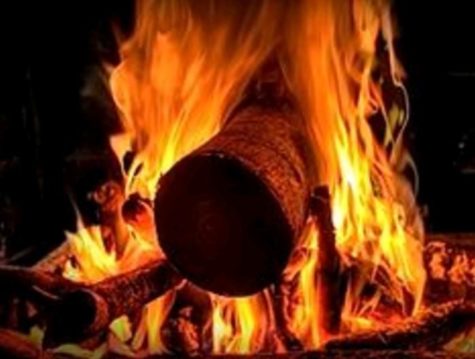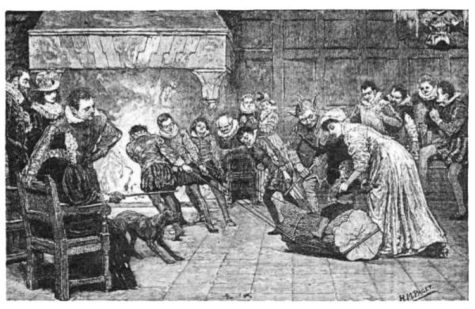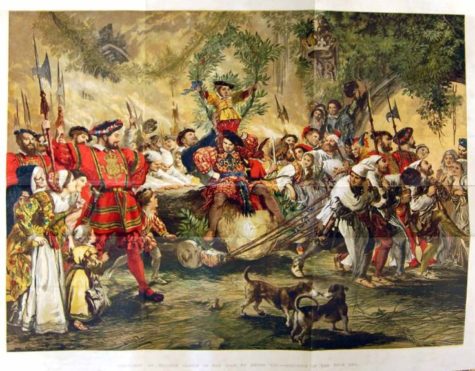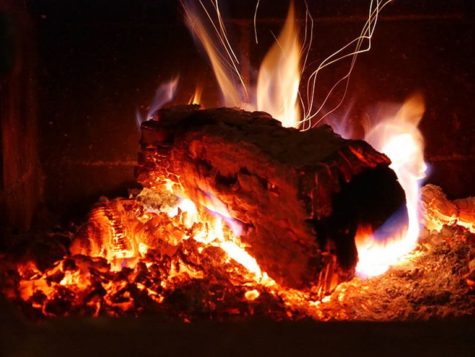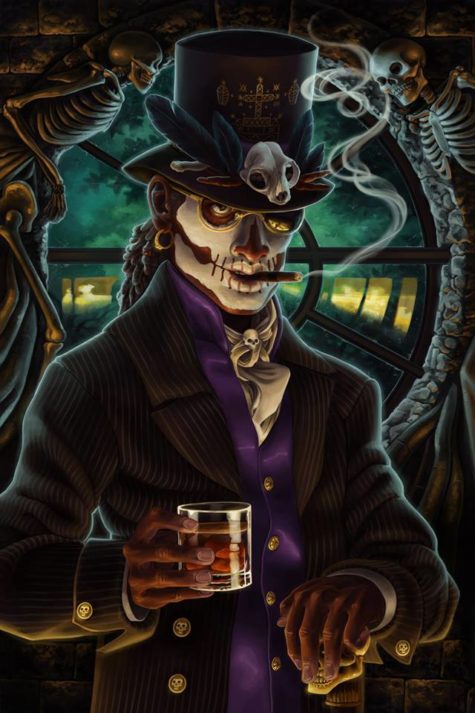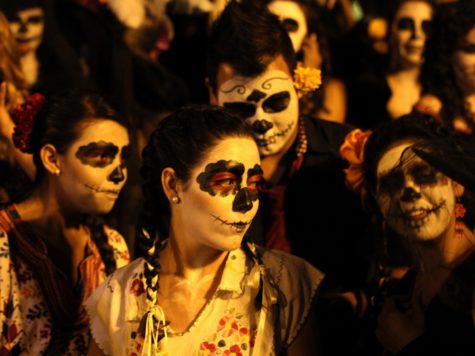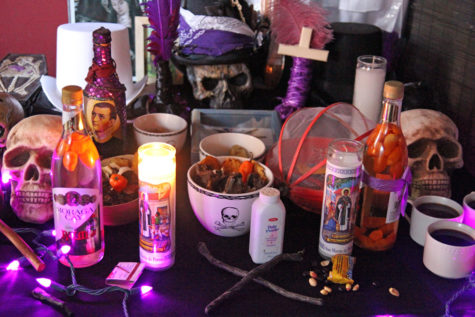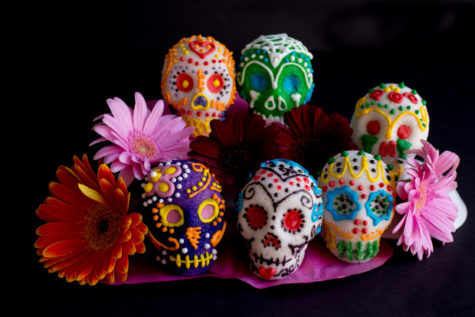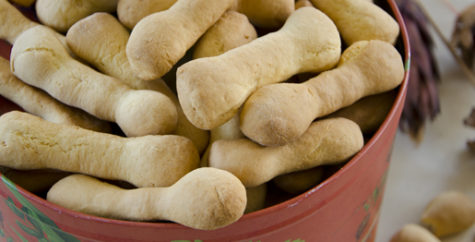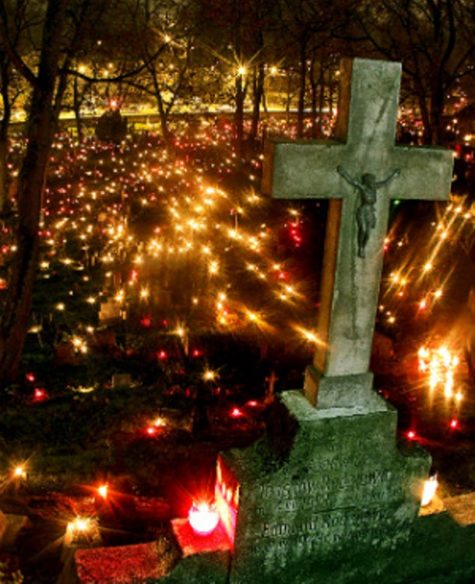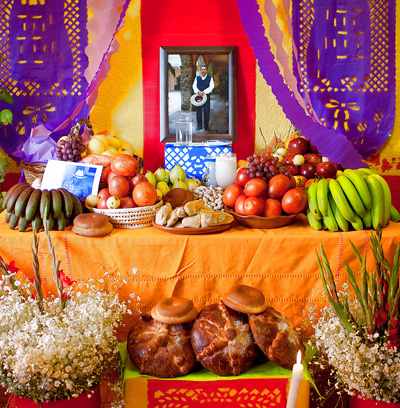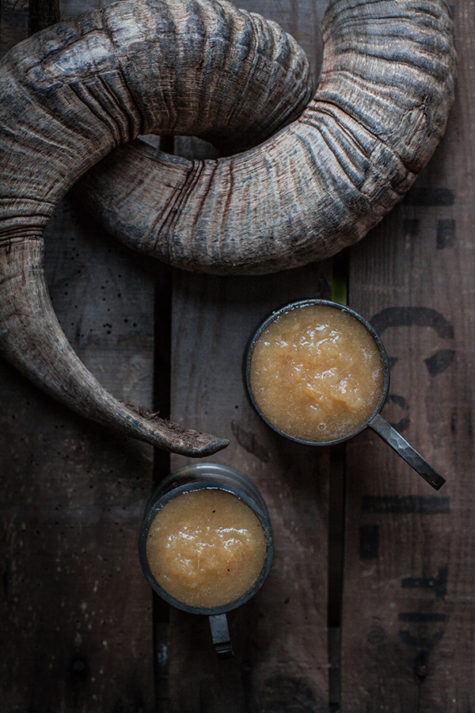Monthly Archives: November 2017
Wassailing means “to wish health to” one’s apple trees, in the hope that they will bear well. In addition, drums, bells, whistles etc. were used either to scare off evil spirits, or to wake the tree up; a libation of cider or ale was poured over the roots, and bread that had soaked in the ‘wassailing’ bowl was placed in the branches – an offering back to the tree.
Note:
Recipes for wassail are numerous and varied. Some call for the use of apple cider, some for wine. The basic idea is that you are making a hot spiced drink and serving it in a bowl amidst love and laughter. Here is a simple recipe that calls for cranberry and orange juice. Feel free to experiment and substitute.
Ingredients:
- 4 cups cranberry juice
- 1/2 cup grenadine
- 2 cups orange juice
- 1/2 cup rum (optional)
- Sugar or honey – to taste
Directions:
Put everything into a large soup or stock pot and bring to a low simmer. If you added honey or sugar, mix gently until it dissolves. Lower the heat and very low simmer the mixture for 2 hours before serving. Keep it on low or use a crockpot on low if serving over hours. The longer you heat, the more infused the flavors will be.
Orange slices or orange wedges studded with cloves, cinnamon sticks, and cranberries can be floated in the pot and simmered along with the rest of the ingredients.
When you are ready to serve your Christmas Wassail, just ladle into your favorite mug and enjoy. This delicious and warm drink is a holiday treat! Garnish with a cinnamon stick if you like.
Source: Earthwitchery
Figgy pudding is a pudding resembling something like a white Christmas pudding containing figs. The pudding may be baked, steamed in the oven, boiled or fried. The history of figgy pudding dates back to 16th century England. Its possible ancestors include savory puddings such as crustades, fygeye or figge (a potage of mashed figs thickened with bread), creme boiled (a kind of stirred custard), and sippets. In any case, its methods and ingredients appear in diverse older recipes.
Today, the term figgy pudding is popularized mainly by the Christmas carol “We Wish You A Merry Christmas,” which includes the line, “Now bring us some figgy pudding” in the chorus.
And here it is (from Food.com) a recipe for Figgy Pudding. This is not a traditional pudding, it’s actually more bread or cake-like. The taste may be a little strange to some, but it smells and tastes like Christmas. The figgy pudding should always be served warm. If you can’t serve it fresh out of the oven, it will taste just fine to warm it in the microwave for a few seconds.
Ingredients:
- 16 ounces dried figs
- 1 3/4 cups milk
- 1 1/2 cups all-purpose flour
- 1 cup sugar
- 2 1/2 teaspoons baking powder
- 1 teaspoon ground nutmeg
- 1 teaspoon ground cinnamon
- 1 teaspoon salt
- 3 eggs
- 1/2 cup melted butter
- 1 1/2 cups breadcrumbs
- 1 tablespoon grated orange peel
Directions:
Preheat oven to 350 degrees F. In a a medium saucepan, heat milk and chopped figs over medium-low heat but do NOT bring to a boil. Cook for 10-15 minutes stirring occasionally. The the milk will soften the figs.
In a medium bowl mix flour, sugar, baking powder, nutmeg, cinnamon, and salt. In a large bowl, beat eggs one minute on high. Reduce speed to low and add butter, bread crumbs, orange peel, and warm fig mixture. Slowly incorporate flour mixture. Beat until just blended.
Pour the mix into the greased bundt pan. Level top as much as possible. Cover the mold with a piece of aluminum foil greased on one side, greased side down. Place the mold in a roasting pan and place on oven rack. fill with hot tap water 2 inches up the side of the mold. Bake for 2 hours or until the pudding is firm and it is pulling away from the side of the bundt pan.
Remove the pudding from the water bath. Remove the foil and cool on a wire rack for 10 minutes before unmolding. Invert bundt pan onto a serving plate and remove mold. It should come away easily.
Serve with a hard sauce.
Yes you can have a family Yule celebration and still have a holiday tree, and hang stockings with care by the fire.
During the Roman festival of Saturnalia, celebrants often decorated their homes with clippings of shrubs, and hung metal ornaments outside on trees. Typically, the ornaments represented a god — either Saturn, or the family’s patron deity. The laurel wreath was a popular decoration as well. The ancient Egyptians didn’t have evergreen trees, but they had palms — and the palm tree was the symbol of resurrection and rebirth. They often brought the fronds into their homes during the time of the winter solstice.
Early Germanic tribes decorated trees with fruit and candles in honour of Odin for the solstice. These are the folks who brought us the words Yule and wassail, as well as the tradition of the Yule Log!
In other words, if you want to have a decorated tree for the holiday, don’t let anyone tell you it doesn’t have Pagan origins. And if you’d like to go for a more authentic pagan look, there are a ton of other things out there you can use.
Here are some ideas:
- Suns and solar ornaments – raid the craft stores and find stars to turn into suns
- Gods Eyes – make then out of cinnamon sticks and seasonal coloured yarn or ribbons
- Pentacles – make them out of shiny chenille stems, bent into stars with circles around them
- Natural objects like acorns, feathers, holly, mistletoe or pine cones
- Lights, lights, and more lights
- Magical items – cups, wands, or daggers
- Fertility symbols – eggs, antlers, horns
On the winter solstice, on the longest night of the year, people would place and set afire an entire tree, that was carefully chosen and brought into the house with great ceremony. The largest end of the log would be placed into the fire hearth while the rest of the tree stuck out into the room! The log would be lit from the remains of the previous year’s log which had been carefully stored away and slowly fed into the fire through the Twelve Days of Christmas.
It was considered important that the re-lighting process was carried out by someone with clean hands.
Tradition has it that the burning of the Yule log was performed to honor the Great Mother Goddess. The log would be lit on the eve of the solstice using the remains of the log from the previous year and would be burned for twelve hours for good luck and protection.
As the fire began all other lights would be extinguished and the people would gather round the fire. In thanksgiving and appreciation for the events of the past year and in bidding the year farewell each person would toss dried holly twigs into the fire.
The next phase of the burning of the Yule log commenced with people tossing oak twigs and acorns into the fire and they would shout out their hopes and resolutions for the coming New Year and sing Yuletide carols. The celebration of the Yule log fire ended with unburned pieces of the Yule log saved to start the fire of next winter’s solstice Yule log.
The custom of the Yule Log spread all over Europe and different kids of wood are used in different countries. In England, Oak is traditional. The “mighty oak” was the most sacred tree of Europe, representing the waxing sun, symbolized endurance, strength, protection, and good luck to people in the coming year. In Scotland, it is Birch; while in France, it’s Cherry. Also, in France, the log is sprinkled with wine, before it is burnt, so that it smells nice when it is lit.
The earliest Yule Log in France can be traced back to Celtic Brittany. When the Catholic Church stamped out the Pagan tradition, it adapted. In the 12th century, the ceremony became more elaborate.
Families would haul home enormous logs and in some regions, the youngest child was allowed to ride the log home. As families dragged their logs home, passers by would raise their hats because they knew the log was full of good promises and its flame would burn out old wrongs.
For the Vikings, the yule log was an integral part of their celebration of the solstice, the julfest; on the log, they would carve runes representing unwanted traits (such as ill fortune or poor honor) that they wanted the gods to take from them.
People would also use the log as a way to predict events in the upcoming year. They would hit the burning log with tongs and the embers emitted would tell them what the harvest would be like. The more embers, the more corn. The fire was read and predictions were made for the coming year based on the sparks and flames they saw, like how many chickens or calves would be born, marriages in the family, health, wealth, etc. If the fire cast shadows on the wall, there would be a death in the family that year.
The remaining cinders would be placed in the soil so they would prevent grain diseases and produce a good harvest. They’d be spread around chicken coops to keep away foxes and in the barns and lofts where corn was stored to keep rats and weevils away. During a storm, throwing a handful into the fire would keep the house safe from lightening.
The ashes of the Yule Log were believed to hold magical and medicinal powers that would ward off evil spirits for the coming year. Ashes from the Yule log are very beneficial to garden plants, however, it is considered very unlucky to throw out the ashes of the Yule log on Christmas day.
Various chemicals can be sprinkled on the log like wine to make the log burn with different colored flames! Here’s a short list. Be sure to follow safety precautions if you plan on using them!!
- Potassium Nitrate = Violet
- Barium Nitrate = Apple Green
- Borax = Vivid Green
- Copper Sulphate = Blue
- Table Salt = Bright Yellow
“It’s like New Year’s Day for the dead.” That’s how Sherly Turenne sums up the celebration for Ghede spirits, led by Baron Samedi, god of death in Haiti’s Vodun tradition.
He is anticipated with happiness as the protector of children, provider of wise advice and the last best hope for the seriously ill. Celebrated on Nov. 2, along with the Catholic All Souls’ Day, Ghede (GEH-day) is also a day to remember and honor ancestors.
All boons granted by the Ghede must be repaid by this date or they will take their vengeance on you.
About the Ghede:
With a population of 8.5 million, Haiti is 90 percent Catholic and 100 percent Vodun (VOH-doon), a religion that accommodated the practices and principles of captives from Dahomey, Yorubaland, Congo and Angola who were brought to the island during the African slave trade.
The Dahomey/Yoruba term can refer both to the verb gede, to cut through, and igede, incantation, hinting at cutting through to mystery, in this case the mystery of death. Because the Africans combined the elements of their various geographical regions, there came to be in Haiti many Ghedes, several Barons and a creole term referring to a formal god, all referring to the dead and death itself.
Ghedes are part of the pantheon of gods known as Loa (Loh-WAH). Ghede then, as the ruler of death and embodying also the principle of resurrection, governs the preservation and renewal of life. He is sometimes also referred to with affection as Papa Ghede.
The Celebration:
People will put on their Sunday best, and go to church first thing in the morning to pray.
Then they will go home and put on the regalia of the ragtag Ghedes, as the spirits of the underworld are often called, or the elegant Baron Samedi (SAHM-dee) in his black, white and purple color scheme. An outfit can be as simple as a white blouse and skirt and purple neck scarf or can include a black top hat and tails, a baton or cane, a red bandanna or multicolored necklaces.
It is also common to wear makeup – painting half the face white with black around the eyes or even just dusting the face with flour. Once dressed, celebrants go to the town cemetery, where those who have ancestors there will clean the tombs of their loved ones and leave food for them in remembrance.
The spiritual adepts, the women called mambos and the men called houngans (HONE-gahn), joined by drummers and singers, will pray at a cross rising from a tomb, the symbol of Baron Samedi, summoning the spirits. And then the partying begins.
The seeming contradiction may be difficult for Americans to comprehend. The god of death, Baron Samedi nevertheless pokes fun at death and with his raunchy humor and suggestive, lewd dancing makes fun of the human passion that brings life.
A typical altar in honor of Ghede would include cigarettes; clarin, a Haitian white rum spiced with habanero peppers; a small white image of a skull; white, black and purple candles; satin fabric in the same colors; crosses; a miniature coffin; sequined bottles and a chromolithograph of St. Gerard, a saint associated with Baron Samedi. No altar would be complete without the requisite top hat and cane.
Preparing a feast
Oakland dance instructor Portsha Jefferson, whose great-grandmother was Haitian, has been celebrating the holiday for years, both at home and as part of a public gathering. She will prepare a veritable feast for her ancestors, including greens, yams, macaroni and cheese, corn bread, red beans and rice, cabbage, baked chicken and fried snapper, with sweet potato pie for their dessert.
She will begin her day by pouring a libation and offering a prayer in thanks and ask for their blessing. Her altar for Ghede will be refreshed with clarin and set with a vase of fresh flowers and a new white candle. Then she’ll pack up her scandalous Ghede outfit, a black gown with silver and purple sequins that is slit on each side to midthigh, borrow the Baron’s top hat and go to the community celebration, which she has been planning with partner Lee Hetelson.
It was started by the Petit la Croix dance company’s Blanche Brown, who taught Haitian dance in the Bay Area for decades; Jefferson, who took it over in 2003, sends out an e-mail to adepts and dancers asking for volunteers.
“I have people set up on the day-of – decorations, constructing the altar, food preparation, hiring musicians, graphic designers for flyers, administrators for marketing,” she said.
Community celebration
Many community celebrations feature special performances, costume contests, dancing and dance workshops, along with the opportunity to have fun. A Ghede feast is a chance for drummers to play and dancers to dance. It has become really popular, with people wearing Ghede’s clothes.
The party also seems to have a spiritual impact on participants. “I’ve been surprised to hear that people – after dancing- it would lighten up their spirit or help them get through whatever problem they were having at the time.”
In Haiti, preparations had been go on for weeks. At traditional worship sites, called hounfours (HOWN-for), devotees prepare the altar with drapo (flags or cloth) in black, white and purple, lay out Ghede’s attire, and soak habanero peppers in vinegar or water to later be added to clarin for the drink few but the Ghedes can bear to swallow.
The food placed around the altar is very important. It is also important that all the things for other gods are put away. This is to make sure that all of The Baron’s needs are there for when he comes.
Spiritual revellers wear white face paint and drink spicy rum during the two day festival. Devotees can be seen eating glass, carrying dead goats, and drinking from bottles of rum infused with fiery peppers at the spiritual bash.
The Haitians head to a sprawling cemetery in the country’s capital of Port-au-Prince, where voodoo priests and priestesses gather around what is thought to be the nation’s oldest grave.
A man dressed as a “Gede”, or spirit of voodoo, greets people as they enter the cemetery
They then light candles and start small fires to recall the spirit of Baron Samedi the guardian of the dead.
The Day of the Dead festival takes place on November 1 and November 2, when voodoo followers remember relatives who have passed away and asks spirits to grant them favours or offer them advice.
Vendors set up in the cemetery and sell things such as rum, candles and rosary beads.
- 2 cups powdered sugar
- 1 egg white
- 1 TBSP. corn syrup
- 1/2 tsp. vanilla
- 1/3 cup cornstarch
- colored icing
- 1 fine paintbrush
Sift powdered sugar. Mix the egg white, corn syrup, and vanilla in a very clean bowl, then add the powdered sugar with a wooden spoon. When almost incorporated, start kneading with the tip of your fingers until you can form a small ball. Dust with cornstarch on board. Keep on kneading until smooth, then form into skull shapes. Let dry completely, then paint with colored icing, including the names of the people you are giving them to.
In Italy, the sine qua non of All Souls’ celebrations is a cookie called “Ossi di Morto,” or “Bones of the Dead.”
Here’s a recipe:
- 1 1/4 cups flour
- 10 oz almonds
- 1/2 cup sugar
- 1 oz pine nuts
- 1 TBSP butter
- A shot glass full of brandy or grappa
- The grated zest of half a lemon
- Cinnamon
- One egg and one egg white, lightly beaten
Blanch the almonds, peel them, and chop them finely (you can do this in a blender, but be careful not to over-chop and liquefy).
Combine all the ingredients except the egg in a bowl, mixing them with a spoon until you have a firm dough. Dust your hands and work surface with flour, and roll the dough out between your palms to make a “snake” about a half inch thick. Cut it into two-inch long pieces on the diagonal. Put on greased and floured cookie sheet, brush with the beaten egg, and bake them in a 330-350 oven for about 20 minutes. Serve them cold. Because they are a dry, hard cookie, it is good to serve these with something to drink.
As usual with big Catholic Feast days, food is involved with the day, with many Catholic families having picnics near their loved ones’ graves. Traditional foods include “Soul Food” — food made of lentils or peas.
Basic Split Pea Soup (serves 4)
- 1 cup chopped onion
- 2 cloves garlic (optional)
- 1 teaspoon vegetable oil or bacon grease
- 1 pound dried split peas
- 1 pound ham bone
- 1 c. chopped ham
- 1 c. chopped carrots (optional)
- salt and pepper to taste
In a medium pot, sauté onions in oil or bacon grease. (Optional: add garlic and sauté until just golden, then remove). Remove from heat and add split peas, ham bone and ham. Add enough water to cover ingredients, and season with salt and pepper.
Cover, and cook until there are no peas left, just a green liquid, 2 hours. (Optional: add carrots halfway through) While it is cooking, check to see if water has evaporated. You may need to add more water as the soup continues to cook.
Once the soup is a green liquid remove from heat, and let stand so it will thicken. Once thickened you may need to heat through to serve. Serve with either sherry or sour cream on top, and with a crusty bread.
There is a Mexican saying that we die three deaths: the first when our bodies die, the second when our bodies are lowered into the earth out of sight, and the third when our loved ones forget us.
Some believe that the origins of All Souls’ Day in European folklore and folk belief are related to customs of ancestor veneration practiced worldwide. It is practically universal folk belief that the souls of the dead (or those in Purgatory) are allowed to return to earth on All Souls Day. In Austria, they are said to wander the forests, praying for release. In Poland, they are said to visit their parish churches at midnight, where a light can be seen because of their presence. Afterward, they visit their families, and to make them welcome, a door or window is left open. In many places, a place is set for the dead at supper, or food is otherwise left out for them.
In any case, our beloved dead should be remembered, commemorated, and prayed for.
During our visits to their graves, we spruce up their resting sites, sprinkling them with holy water, leaving votive candles, and adorning them flowers (especially chrysanthemums and marigolds) to symbolize the Eden-like paradise that man was created to enjoy, and may, if saved, enjoy after death and any needed purgation.
Today is a good day to not only remember the dead spiritually, but to tell your children about their ancestors. Bring out those old photo albums and family trees! Write down your family’s stories for your children and grandchildren! Impress upon them the importance of their ancestors!
Traditional foods:
Around the world:
The formal commemoration of the saints and martyrs (All Saints’ Day) existed in the early Christian church since its legalization, and alongside that developed a day for commemoration of all the dead (All Souls’ Day). The modern date of All Souls’ Day was first popularized in the early eleventh century after Abbot Odilo established it as a day for the monks of Cluny and associated monasteries to pray for the souls in purgatory.
Many of these European traditions reflect the dogma of purgatory. For example, ringing bells for the dead was believed to comfort them in their cleansing there, while the sharing of soul cakes with the poor helped to buy the dead a bit of respite from the suffering of purgatory. In the same way, lighting candles was meant to kindle a light for the dead souls languishing in the darkness. Out of this grew the traditions of “going souling” and the baking of special types of bread or cakes.
In Tirol, cakes are left for them on the table and the room kept warm for their comfort. In Brittany, people flock to the cemeteries at nightfall to kneel, bareheaded, at the graves of their loved ones, and to anoint the hollow of the tombstone with holy water or to pour libations of milk on it. At bedtime, the supper is left on the table for the souls.
In Bolivia, many people believe that the dead eat the food that is left out for them. In Brazil people attend a Mass or visit the cemetery taking flowers to decorate their relatives’ grave, but no food is involved.
In Malta many people make pilgrimages to graveyards, not just to visit the graves of their dead relatives, but to experience the special day in all its significance. Visits are not restricted to this day alone. During the month of November, Malta’s cemeteries are frequented by families of the departed. Mass is also said throughout the month, with certain Catholic parishes organizing special events at cemetery chapels.
In Linz, funereal musical pieces known as aequales were played from tower tops on All Soul’s Day and the evening before.
In Mexico “Dia de Los Muertos” (Day of the Dead) is celebrated very joyfully — and colorfully. A special altar, called an ofrenda, is made just for these days of the dead (1 and 2 November). It has at least three tiers, and is covered with pictures of Saints, pictures of and personal items belonging to dead loved ones, skulls, pictures of cavorting skeletons (calaveras), marigolds, water, salt, bread, and a candle for each of their dead (plus one extra so no one is left out).
A special bread is baked just for this day, Pan de Muerto, which is sometimes baked with a toy skeleton inside. The one who finds the skeleton will have “good luck.” This bread is eaten during picnics at the graves along with tamales, cookies, and chocolate. They also make brightly-colored skulls out of sugar to place on the family altars and give to children.
Collected from various sources
On the first of November, it was an ancient Celtic practice to indulge in a sort of feast, which was called la mas ubhal, the day of the apple fruit, because on that occasion, roasted apples were bruised and mixed in ale, milk, or by those who could afford it, in wine. This is the origin of lamb’s wool.
About Lambs Wool:
The basic recipe for lambswool is as follows: Apples are roasted in a pan on the fire, or on a string over the fire, until they sizzle. They are then dropped, still hot, into the warmed, spiced, sweetened ale.
In Gerard’s Herbal (1633) it is described as a drink of warmed, spiced ale or cider, in which bob roasted apples: ‘sometimes, eggs or cream, or both, are whisked in, and sometimes it is served poured over small fruit cakes.’
It derives its name from the day which is dedicated to the Angel presiding over fruits and seeds, which was originally called “La Maso bal” which was corrupted to Lamb’s Wool. According to Nell Heaton writing in the late 1940’s. Alternatively, the name could simply be a reference to the fluffy appearance of the pulp of the roast apples, bobbing about in the warm brew.
From: The Scotish Gaël and Celebration



